Ironically, the flourishing virtual platform that enables people to connect and share creativity – Instagram – has become a hotbed of improper photos, such as sexually suggestive and explicit pictures. More and more people are running adult (couple/sex/love) accounts for more attention and making money.
As children engage in the digital environment, it’s becoming increasingly challenging to shield them from potentially harmful materials.
This article provides you with the basic guidelines for how to protect your kids from what is hidden behind Instagram.
Does Instagram allow NSFW pictures?



Instagram, a social media platform enjoyed by millions of users, has many nuances when it comes to defining content suitability.
Though it’s strictly prohibited to upload naked pictures, the site has been criticized for the selective enforcement of this rule.
Its age limit of 13+ is, in many cases, conflicting due to the reality of the existence of underage persons who are always using fake details to access the platform.
Instagram considers the following inappropriate:
- Nudity or partial nudity
- Sexual acts
- Sexually suggestive poses
- Close-ups of genitalia
- Sexual violence or exploitation
If a user finds a picture lewd, they can report or block it. Instagram then assesses the picture and can delete it, suspend the account, or even ban the account. For this process, they employ both artificial intelligence and human moderators.
However, there are always some gaps. For example, it allows creating private accounts, using banned words or #hashtags, or simply reposting content deleted by the administration.
There may be some recommendations that do not contradict the rules but can still be considered questionable in the context of children.
4 Ways to block sexually suggestive pictures on Instagram
Sharing sexually suggestive pictures on Instagram may attract attention and increase followers soon, but they also come with significant risks, including potential violations of community guidelines and harm to personal reputation. Overly exposure to adult content has left many young people with deformed personal values and body images.
Keeping your children away from the devastating effects of sexually suggestive pictures and sexting on Instagram is not very easy and requires more than one strategy. Here are four effective methods you should know.



1. Set up Instagram’s built-in features
Fortunately, Instagram provides several options related to the protection of its users. Here’s how to utilize them:
- Private account
Make sure that your child’s Instagram account is private. This reduces the possibility of strangers accessing their profiles, photos, and videos.
Navigate to your profile, open the three-line menu at the top right of your screen, go to Settings, then Privacy, and switch on the Private Account option.
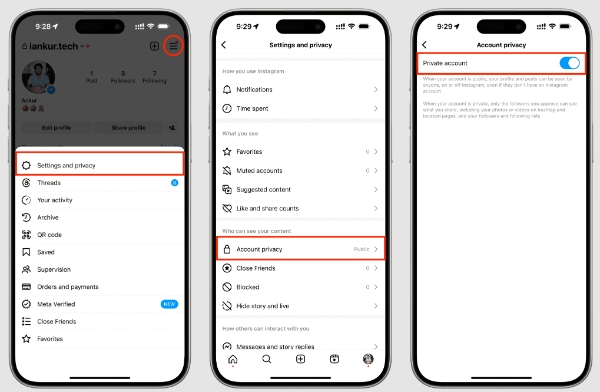


- Sensitive content control
This feature helps you block and restrict the sensitive content, including sexually suggestive pictures, insulting language, and negative information, that your child is able to come across on Instagram.
Navigate to the settings tab, followed by the privacy tab, and then select “Sensitive Content Control.” Determine the preferred level of restriction.
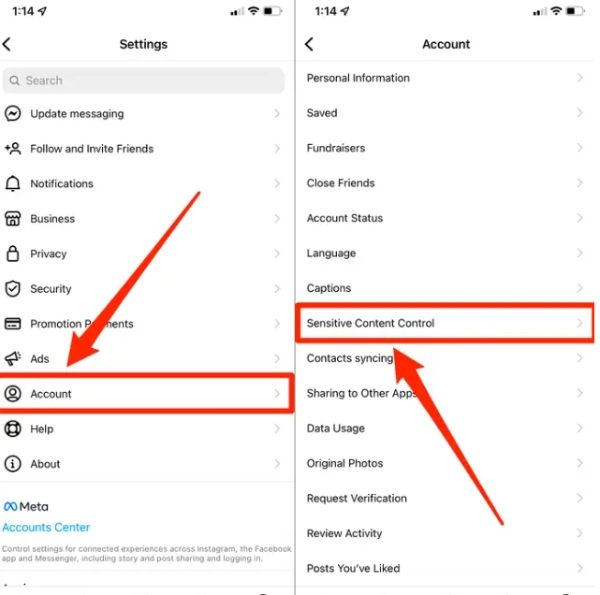


- Block or report inappropriate posts
Explain to your child to report any material that contains or leads to sexual suggestion or graphic content.
Click on the icon in the top right corner of the post that looks like three dots, choose “Report,” and follow the further instructions.
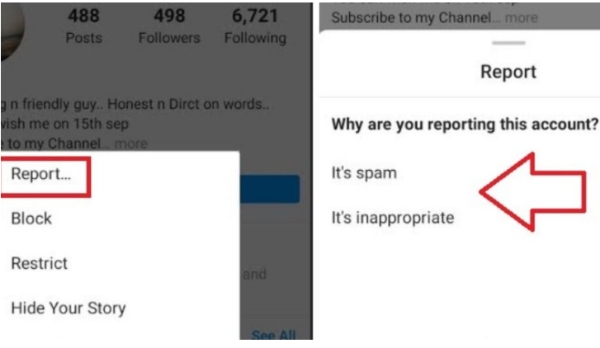


- Block individuals
If someone is harassing and sending sexually suggestive messages with pictures or links, deny his/her access to messaging you right away.
Click on their profile, click on the three dots symbol at the upper right, and choose “Block.”
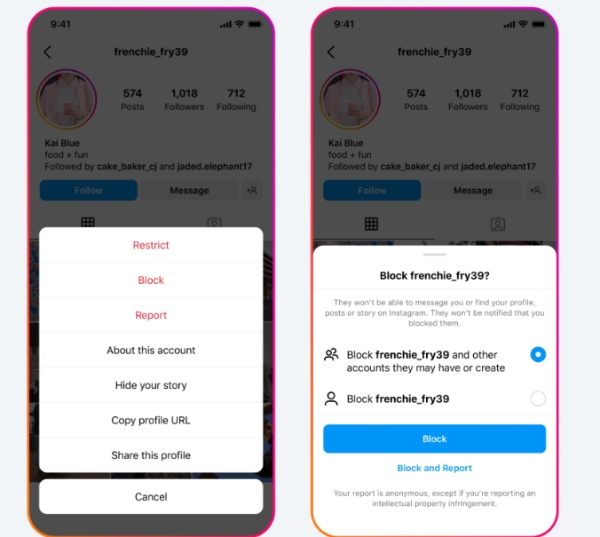


- Disable public messages
You should be able to control the people who can send your child direct messages.
Click on “Settings,” then click “Privacy. ” Under it, click “Messages” and select who can send you messages.
2. Utilize parental control apps
Parental control is a great method of ensuring comprehensive protection of your child’s online sessions.
Among parental control apps, FlashGet Kids is one example of an application that has a wide range of monitoring functions that can help ensure kids’ online safety.
Key features that it offers include app blocking, restriction of screen time spent using the gadgets, and content filtering, which makes Instagram safer to use.



To use FlashGet Kids:
- Download and install the corresponding apps on the parent’s and target devices.
- Create the parent’s account and bind parents’ and kids’ devices with digit codes.
- Allow permissions and configure Instagram-specific settings.
- Analyze the activity through the parent’s account dashboard.
3. Content filtering on smartphones
A lot of modern mobile devices have integrated tools for content filtering into their systems. Check your device’s settings for features like:
- Safe search: Enabling this feature will restrict you from getting vulgar search results in search engines on your device.
- Content restrictions: Reduce the functionality of the apps your child is allowed to use. These may include the use of Instagram and similar platforms.
To be able to implement these features, you need to follow the following steps.
For iOS:
- Open the Settings on your device, then tap on Screen Time > Content & Privacy Restrictions.
- Allow for the setting up of a limit and PIN code.
- In “Content Restrictions,” you can restrict Instagram from “Apps” and choose the age rating.
- More options like “Web Content” will filter adult content.
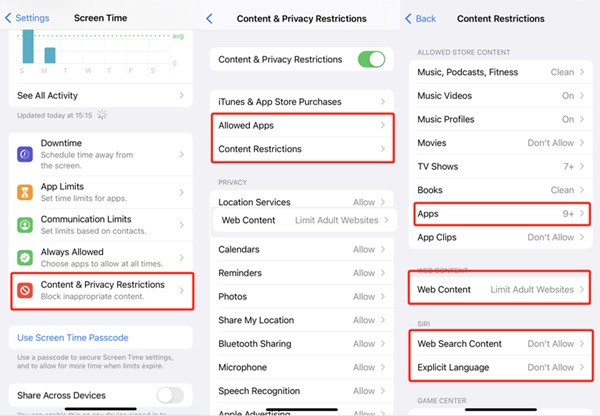


For Android:
- Signing for Google’s Family Link app.
- Create the parent and child accounts.
- Configuring and controlling permissions of the applications and protecting contents.
4. Use browser extensions (for PC)
If your child is accessing Instagram from a computer then there are certain add-ons and extensions available that will help in filtering obscene content.
These extensions can prevent the child from visiting undesirable sites and save him from potentially violent sexual material.
To install:
- Go to your browser’s extension store.
- Find the extension to install, whether it is Social Fixer, uBlock Origin, or LeechBlock NG.
- Look for the “Add to [Browser]” tab and complete the installation procedures.
In this way, with these methods, the parents will be able to minimize the chance their children stumble upon provocative content on IG and enjoy a safer browsing experience.
What are the risks of Instagram for kids?
Although the issue of sexually suggestive pictures and videos is one of the highlights still, it is important to mention that Instagram has other dangerous aspects for children. From peer pressure and body image problems to privacy and security concerns, there are more risks that parents should know.
- Unrealistic beauty standards: Instagram, in particular, is littered with pictures taken and posed in a manner that can often lead to the development of unhealthy body images.
- Fear of missing out (FOMO): Comparing oneself with other people daily, especially with individuals whose lives appear perfect on social networking sites, results in low self-esteem and insignificance.
- Cyberbullying: cyberbullying that involves using Instagram is when the bullies intimidate their targets with nasty comments, bad messages, or even share humiliating images or videos of them.
- Online predators: Children might come across individuals who form friendships with the kids with the intention of luring them into providing details.
- Scams on Instagram: These can include phishing, fake giveaways, or any kind of offer made to users.
- Data collection: The social media platform Instagram has been found to harvest large amounts of user data, thus raising questions on privacy issues.
- Location sharing: Excessive sharing of location information poses risks for children.
- Impersonation: Cybercriminals could catfish using fake social accounts to represent other people.
- Excessive screen time: The negative effects associated with excessive Instagram usage include eye strain, sleeping disorders, poor academic performance, and social disorders.
- Mental health impact: Research has further revealed that negative comparisons, cyberbullying, and online harassment have negative effects on people’s anxiety, depression, and self-esteem.
That is why recognising and acknowledging these risks, the parents will be able to safeguard their children from the negative effects that using Instagram may have.
Tips for safeguarding your children on apps like Instagram
Safeguarding teens now implies the use of strategies starting from simple communication combined with an appropriate choice of technological devices. Here are some essential tips:
Foster open communication
- Talk regularly: Discuss general concepts of Internet safety, threats, and appropriate representation on social media networks with family members and friends.
- Create a safe space: Let your teen know that he/ she should report to you if he/ she stumbles on the line regarding any material or event that concerns him/her.
- Set expectations: Explain the expectations as to how the students will conduct themselves online and how they will respect other’s space and time, among others.
Teach digital literacy
- Identify inappropriate content: Educate your teen on how to reason for himself to avoid problematic content, such as obscene, abusive, or full of scams.
- Understand privacy settings: Explain to your teen ways in which they can control their privacy and who can access the information that they are sharing.
- Beware of online predators: Teach your teen about the tricks employed by online predators and how he or she should not fall victim.
Utilize technology
- Family sharing: Parental controls may be useful to track and limit the downloading of applications, as well as their purchases.
- Set restrictions: Take advantage of settings and features to block specific content and prevent the usage of some apps or web pages.
- Stay informed: Learn more about the tendencies observed in the sphere of social networks, as well as the risks that threaten your child.
With the practice of these measures and patient communication with your teens, it is possible to significantly increase the safety of children on social networks.
Final words
You need to be proactive and on the lookout to safeguard your child from the seemingly endless threat of sexually suggestive pictures and other risky messages on Instagram.
In this implementation guide, parents have learned about the platform’s drawbacks, enabling them to provide a safer digital environment for children while online.
Please bear in mind that the world is constantly shifting, and hence, you should endeavor to protect your child at all times through engaging in continuous learning.
FAQs
Is sexting illegal on Instagram?
Sexting on Instagram is a violation of the platform rules and can be criminal, particularly if the individuals are under eighteen years old. It may lead to account suspension and may also attract legal proceedings.
Can Instagram completely block all explicit content for my child?
Luckily, Instagram has safety features, but they cannot fully shield users from viewing provocative pictures. The most effective protection from unwanted viewing is to use built-in tools, parental supervision, and open conversations with the child.
Should I allow my 12-year-old to have Instagram?
The minimum age on Instagram is 13, and therefore, 12 is below the set limit. However, if you decide to let your child have a profile on the site of your choice, make sure that privacy levels are set to private, and supervise your child.
How can I monitor my child’s Instagram?
You can simply follow your child’s Instagram account or use other parental control apps like FlashGet Kids to track their phone. Be sure to always monitor their activity friends list and sit down with them to discuss what they are engaging in online.

